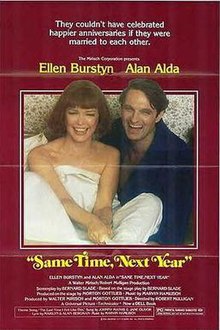Same Time, Next Year (film)
| Same Time, Next Year | |
|---|---|

Theatrical release poster
|
|
| Directed by | Robert Mulligan |
| Produced by | Walter Mirisch |
| Written by | Bernard Slade |
| Starring |
Ellen Burstyn Alan Alda |
| Music by | Marvin Hamlisch |
| Cinematography | Robert Surtees |
| Edited by | Sheldon Kahn |
| Distributed by | Universal Pictures |
|
Release date
|
November 22, 1978 |
|
Running time
|
119 minutes |
| Country | United States |
| Language | English |
| Box office | $19,703,082 |
Same Time, Next Year is a 1978 American romantic comedy-drama film directed by Robert Mulligan. The screenplay by Bernard Slade is based on his 1975 play of the same title. The film stars Alan Alda and Ellen Burstyn.
In 1951, at an inn located on the Mendocino County coast, Doris (Ellen Burstyn), a 24-year-old housewife from Oakland, meets George (Alan Alda) a 27-year-old accountant from New Jersey at dinner. They have a sexual tryst, and then agree to meet once a year to rekindle the sparks they experience at their first meeting, despite the fact that both are happily married, with six children between them. They each discuss their respective yet unseen spouses, "Harry" and "Helen."
Over the course of the next 26 years, they develop an emotional intimacy deeper than what one would expect to find between two people meeting for a clandestine relationship just once a year. During the time they spend with each other, they discuss births, deaths, including George's son Michael dying in Vietnam, which changes George politically, and marital problems each experiences at home, while they adapt themselves to the social changes affecting their lives.
At their meeting in 1977, George explains that his wife, Helen, has died of cancer earlier in the year, and revealed to a friend that she had known of the affair for 10 years without telling George. Now a widower, George proposes to Doris who refuses to accept because of her loyalty to, and respect for, Harry. Rejected, George leaves for good, only to return with the promise to continue the affair as long as they are able.
The movie is structured as six episodes, each occurring approximately five years apart. Between the scenes are shown a series of photos that depict cultural and political events that had ensued in the years between each segment, such as Harry S. Truman, Nikita Khrushchev, Lucille Ball, Elvis, and John F. Kennedy. The episodes are period-specific, often making references to what was actually happening during the time portrayed. For example, in the segment set in 1966, Doris is caught up in the protest movement at Berkeley, while George takes a Librium and reveals that he'd voted for Barry Goldwater, and later that his son had been killed in Vietnam.
...
Wikipedia
